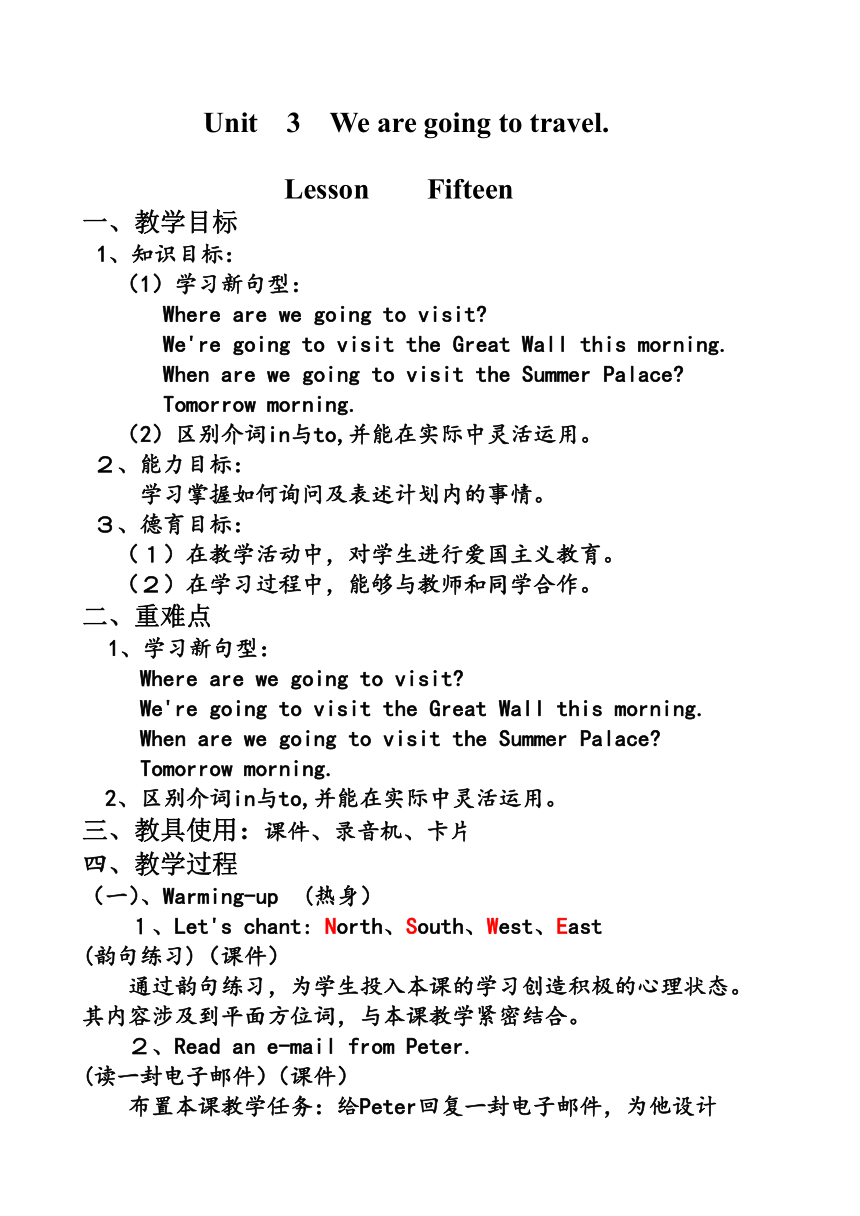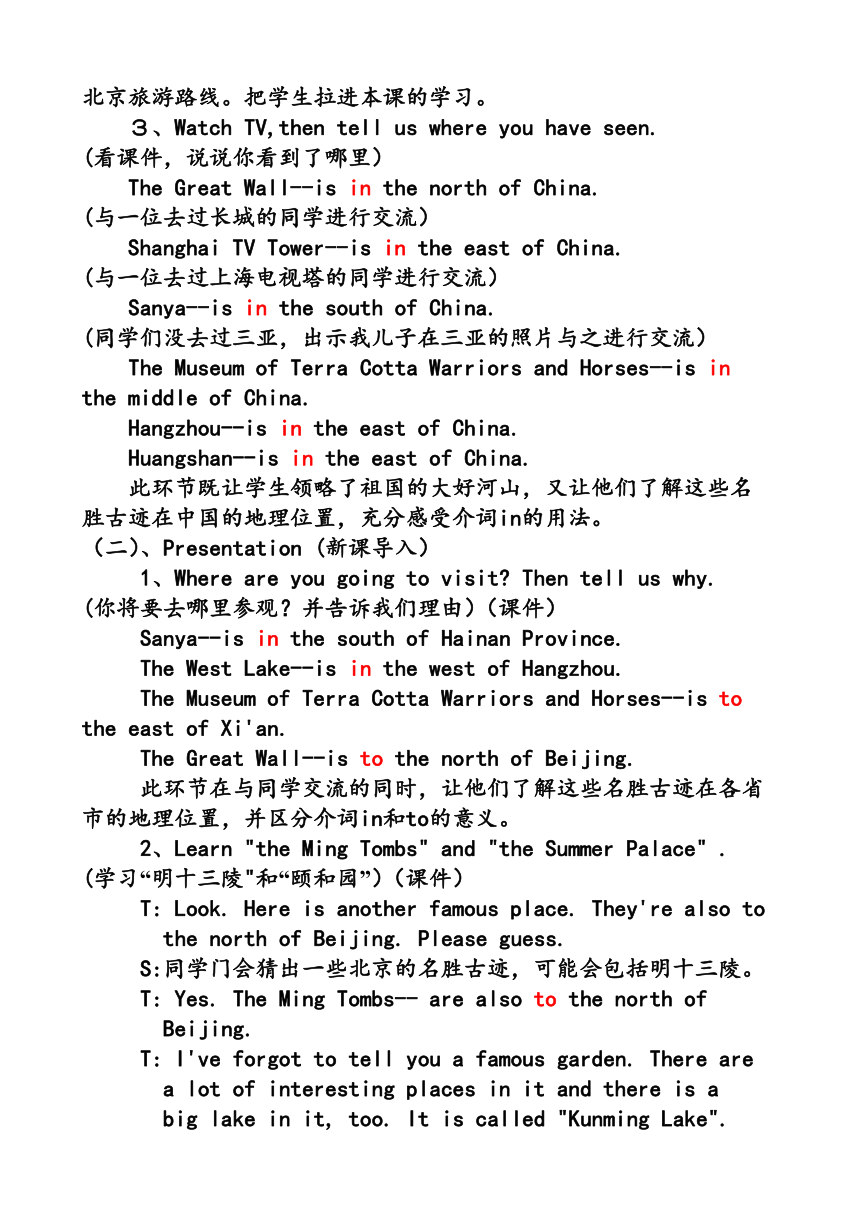Unit3 We are going to travel Lesson15 教案
文档属性
| 名称 | Unit3 We are going to travel Lesson15 教案 |  | |
| 格式 | zip | ||
| 文件大小 | 39.5KB | ||
| 资源类型 | 教案 | ||
| 版本资源 | 人教精通版(三年级起点) | ||
| 科目 | 英语 | ||
| 更新时间 | 2021-07-07 17:17:55 | ||
图片预览


文档简介
Unit
3
We
are
going
to
travel.
Lesson
Fifteen
一、教学目标
1、知识目标:
(1)学习新句型:
Where
are
we
going
to
visit?
We're
going
to
visit
the
Great
Wall
this
morning.
When
are
we
going
to
visit
the
Summer
Palace?
Tomorrow
morning.
(2)区别介词in与to,并能在实际中灵活运用。
2、能力目标:
学习掌握如何询问及表述计划内的事情。
3、德育目标:
(1)在教学活动中,对学生进行爱国主义教育。
(2)在学习过程中,能够与教师和同学合作。
二、重难点
1、学习新句型:
Where
are
we
going
to
visit?
We're
going
to
visit
the
Great
Wall
this
morning.
When
are
we
going
to
visit
the
Summer
Palace?
Tomorrow
morning.
2、区别介词in与to,并能在实际中灵活运用。
三、教具使用:课件、录音机、卡片
四、教学过程
(一)、Warming-up
(热身)
1、Let's
chant:
North、South、West、East
(韵句练习)(课件)
通过韵句练习,为学生投入本课的学习创造积极的心理状态。
其内容涉及到平面方位词,与本课教学紧密结合。
2、Read
an
e-mail
from
Peter.
(读一封电子邮件)(课件)
布置本课教学任务:给Peter回复一封电子邮件,为他设计
北京旅游路线。把学生拉进本课的学习。
3、Watch
TV,then
tell
us
where
you
have
seen.
(看课件,说说你看到了哪里)
The
Great
Wall--is
in
the
north
of
China.
(与一位去过长城的同学进行交流)
Shanghai
TV
Tower--is
in
the
east
of
China.
(与一位去过上海电视塔的同学进行交流)
Sanya--is
in
the
south
of
China.
(同学们没去过三亚,出示我儿子在三亚的照片与之进行交流)
The
Museum
of
Terra
Cotta
Warriors
and
Horses--is
in
the
middle
of
China.
Hangzhou--is
in
the
east
of
China.
Huangshan--is
in
the
east
of
China.
此环节既让学生领略了祖国的大好河山,又让他们了解这些名
胜古迹在中国的地理位置,充分感受介词in的用法。
(二)、Presentation
(新课导入)
1、Where
are
you
going
to
visit?
Then
tell
us
why.
(你将要去哪里参观?并告诉我们理由)(课件)
Sanya--is
in
the
south
of
Hainan
Province.
The
West
Lake--is
in
the
west
of
Hangzhou.
The
Museum
of
Terra
Cotta
Warriors
and
Horses--is
to
the
east
of
Xi'an.
The
Great
Wall--is
to
the
north
of
Beijing.
此环节在与同学交流的同时,让他们了解这些名胜古迹在各省
市的地理位置,并区分介词in和to的意义。
2、Learn
"the
Ming
Tombs"
and
"the
Summer
Palace"
.
(学习“明十三陵"和“颐和园”)(课件)
T:
Look.
Here
is
another
famous
place.
They're
also
to
the
north
of
Beijing.
Please
guess.
S:同学门会猜出一些北京的名胜古迹,可能会包括明十三陵。
T:
Yes.
The
Ming
Tombs--
are
also
to
the
north
of
Beijing.
T:
I've
forgot
to
tell
you
a
famous
garden.
There
are
a
lot
of
interesting
places
in
it
and
there
is
a
big
lake
in
it,
too.
It
is
called
"Kunming
Lake".
S:
The
Summer
Palace.
T:
Yes.
The
Summer
Palace--is
in
the
northwest
of
Beijing.
此环节既学习了课文中的两处名胜古迹,又巩固了介词in
和to的用法。
3、Learn
a
new
text.
(学习课文)(课件)
T:
Watch
TV
and
then
answer
these
questions.
(1)、Who
is
the
man
with
a
flag?
(2)、Who
are
going
to
visit
with
Peter?
(3)、Where
are
they
going
to
visit?
(4)、How
long
are
they
going
to
visit?
此环节在重点突破之后,让学生回归到原文中学习。
(三)、Practice
(练习)
1、Check
up
your
listening.
[听力练习--书P68(2)]
Listen
and
number.
此项练习是针对前面所学名胜古迹的复习。
2、Make
a
travel
plan
for
Peter
in
groups.
Then
talk
about
your
plans.
(各小组为Peter制作旅游计划,然后谈论)(课件和卡片)
完成开课时布置的教学任务:给Peter回复一封电子邮件,为他
设计北京旅游路线,首尾呼应。
(四)、Homework
(作业)
Show
you
my
e-mail,
then
send
it
to
Peter.
(展示我给Peter回复的电子邮件,并发送)(课件)
A:
Write
an
e-mail
to
Peter.
E-mail
Address:
Peter1995@
B:
If
they
are
going
to
visit
Tianjin,
please
make
a
plan
for
them.
T:
You
can
choose
A
or
B
as
your
homework.
A项作业顺理成章,并升华了课文内容。B项作业更贴近学生
生活实际。二选一,体现了“以人为本”的教育理念。
(五)、Assessment
(课堂评价)
1、语言评价---Good、Better、Excellent......
2、北京的名胜古迹小卡片作为奖励,还可以用在制作旅游
计划中,小卡片得到了充分利用。
五、板书设计
(略)
3
We
are
going
to
travel.
Lesson
Fifteen
一、教学目标
1、知识目标:
(1)学习新句型:
Where
are
we
going
to
visit?
We're
going
to
visit
the
Great
Wall
this
morning.
When
are
we
going
to
visit
the
Summer
Palace?
Tomorrow
morning.
(2)区别介词in与to,并能在实际中灵活运用。
2、能力目标:
学习掌握如何询问及表述计划内的事情。
3、德育目标:
(1)在教学活动中,对学生进行爱国主义教育。
(2)在学习过程中,能够与教师和同学合作。
二、重难点
1、学习新句型:
Where
are
we
going
to
visit?
We're
going
to
visit
the
Great
Wall
this
morning.
When
are
we
going
to
visit
the
Summer
Palace?
Tomorrow
morning.
2、区别介词in与to,并能在实际中灵活运用。
三、教具使用:课件、录音机、卡片
四、教学过程
(一)、Warming-up
(热身)
1、Let's
chant:
North、South、West、East
(韵句练习)(课件)
通过韵句练习,为学生投入本课的学习创造积极的心理状态。
其内容涉及到平面方位词,与本课教学紧密结合。
2、Read
an
from
Peter.
(读一封电子邮件)(课件)
布置本课教学任务:给Peter回复一封电子邮件,为他设计
北京旅游路线。把学生拉进本课的学习。
3、Watch
TV,then
tell
us
where
you
have
seen.
(看课件,说说你看到了哪里)
The
Great
Wall--is
in
the
north
of
China.
(与一位去过长城的同学进行交流)
Shanghai
TV
Tower--is
in
the
east
of
China.
(与一位去过上海电视塔的同学进行交流)
Sanya--is
in
the
south
of
China.
(同学们没去过三亚,出示我儿子在三亚的照片与之进行交流)
The
Museum
of
Terra
Cotta
Warriors
and
Horses--is
in
the
middle
of
China.
Hangzhou--is
in
the
east
of
China.
Huangshan--is
in
the
east
of
China.
此环节既让学生领略了祖国的大好河山,又让他们了解这些名
胜古迹在中国的地理位置,充分感受介词in的用法。
(二)、Presentation
(新课导入)
1、Where
are
you
going
to
visit?
Then
tell
us
why.
(你将要去哪里参观?并告诉我们理由)(课件)
Sanya--is
in
the
south
of
Hainan
Province.
The
West
Lake--is
in
the
west
of
Hangzhou.
The
Museum
of
Terra
Cotta
Warriors
and
Horses--is
to
the
east
of
Xi'an.
The
Great
Wall--is
to
the
north
of
Beijing.
此环节在与同学交流的同时,让他们了解这些名胜古迹在各省
市的地理位置,并区分介词in和to的意义。
2、Learn
"the
Ming
Tombs"
and
"the
Summer
Palace"
.
(学习“明十三陵"和“颐和园”)(课件)
T:
Look.
Here
is
another
famous
place.
They're
also
to
the
north
of
Beijing.
Please
guess.
S:同学门会猜出一些北京的名胜古迹,可能会包括明十三陵。
T:
Yes.
The
Ming
Tombs--
are
also
to
the
north
of
Beijing.
T:
I've
forgot
to
tell
you
a
famous
garden.
There
are
a
lot
of
interesting
places
in
it
and
there
is
a
big
lake
in
it,
too.
It
is
called
"Kunming
Lake".
S:
The
Summer
Palace.
T:
Yes.
The
Summer
Palace--is
in
the
northwest
of
Beijing.
此环节既学习了课文中的两处名胜古迹,又巩固了介词in
和to的用法。
3、Learn
a
new
text.
(学习课文)(课件)
T:
Watch
TV
and
then
answer
these
questions.
(1)、Who
is
the
man
with
a
flag?
(2)、Who
are
going
to
visit
with
Peter?
(3)、Where
are
they
going
to
visit?
(4)、How
long
are
they
going
to
visit?
此环节在重点突破之后,让学生回归到原文中学习。
(三)、Practice
(练习)
1、Check
up
your
listening.
[听力练习--书P68(2)]
Listen
and
number.
此项练习是针对前面所学名胜古迹的复习。
2、Make
a
travel
plan
for
Peter
in
groups.
Then
talk
about
your
plans.
(各小组为Peter制作旅游计划,然后谈论)(课件和卡片)
完成开课时布置的教学任务:给Peter回复一封电子邮件,为他
设计北京旅游路线,首尾呼应。
(四)、Homework
(作业)
Show
you
my
e-mail,
then
send
it
to
Peter.
(展示我给Peter回复的电子邮件,并发送)(课件)
A:
Write
an
to
Peter.
Address:
Peter1995@
B:
If
they
are
going
to
visit
Tianjin,
please
make
a
plan
for
them.
T:
You
can
choose
A
or
B
as
your
homework.
A项作业顺理成章,并升华了课文内容。B项作业更贴近学生
生活实际。二选一,体现了“以人为本”的教育理念。
(五)、Assessment
(课堂评价)
1、语言评价---Good、Better、Excellent......
2、北京的名胜古迹小卡片作为奖励,还可以用在制作旅游
计划中,小卡片得到了充分利用。
五、板书设计
(略)
同课章节目录
- Unit 1 I went to Sanya for my holidays.
- Lesson 1
- Lesson 2
- Lesson 3
- Lesson 4
- Lesson 5
- Lesson 6
- Unit 2 There is a park near my home.
- Lesson 7
- Lesson 8
- Lesson 9
- Lesson 10
- Lesson 11
- Lesson 12
- Unit 3 We are going to travel.
- Lesson 13
- Lesson 14
- Lesson 15
- Lesson 16
- Lesson 17
- Lesson 18
- Fun Time 1
- Recycle 1
- Recycle 2
- Fun Reading
- Unit 4 General Revision 1
- Task 1-Task 2
- Task 3-Task 4
- Task 5-Task 6
- Task 7-Task 8
- Task 9-Task 10
- Task 11-Task 12
- Unit 5 General Revision 2
- Task 1-Task 2
- Task 3-Task 4
- Task 5-Task 6
- Task 7-Task 8
- Task 9-Task 10
- Task 11-Task 12
- Unit 6 General Revision 3
- Task 1-Task 2
- Task 3-Task 4
- Task 5-Task 6
- Task 7-Task 8
- Task 9-Task 10
- Task 11
- 旧版资料
- Unit 1 How was your holiday?
- Unit 2 Let's talk about the past.
- Unit 4 We are going to visit the Great Wall.
- Unit 5 Save our planet.
- Unit 6 How do you learn?
